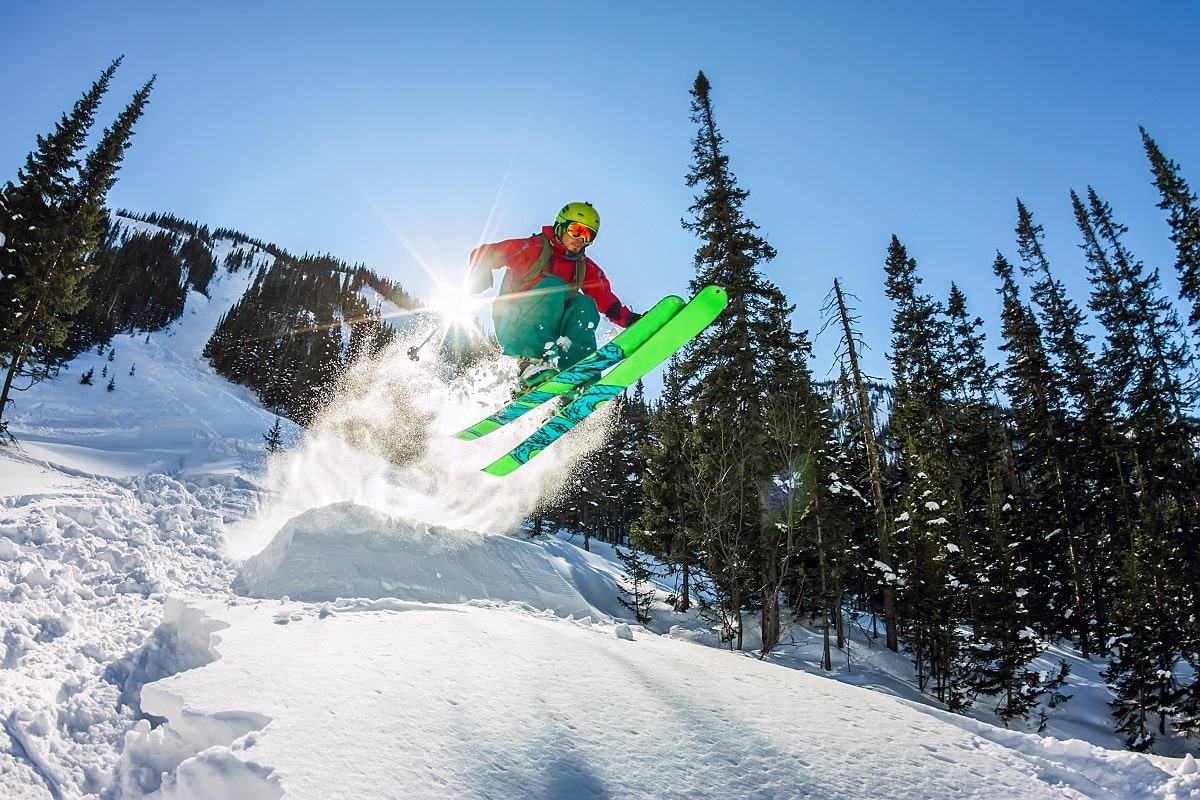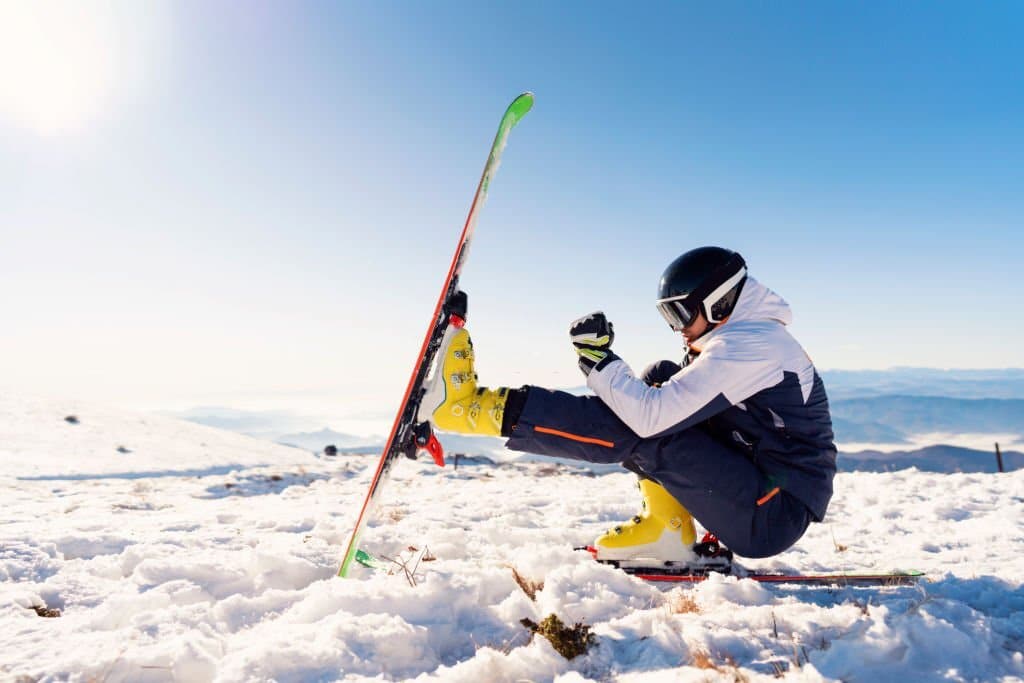What Equipment Is Needed For Freestyle Skiing? (Park Vs Big Mountain)
Since freestyle skiing consists of fast, technical, high-impact, and airborne skiing, the equipment necessary needs to be able to handle this skiing style. What equipment is best for freestyle skiing and how does it differ from other types of equipment?
Big mountain and backcountry skiing will require very different skis, boots, and bindings than terrain park skiers will need. Terrain park equipment will be much softer, allowing the skier to adapt to changing conditions on the fly, whereas big mountain equipment will be much stiffer to absorb higher impacts and changing snow conditions.

We are reader supported. We may collect a share of sales from the links on this page. As an Amazon Associate, we earn from qualifying purchases.
Ski Flex
Terrain Park Ski Flex
Check Price on Backcountry.com
Terrain park skis have softer cores, making them much more flexible and snappy than their big mountain counterparts. They need to be very lightweight while being strong enough to absorb high-impact landings. Some of these cores include:
- Poplar
- Beech
- Birch
- Aspen
- Bamboo
- Fir
- Balsa
- Scotch Pine
- Foam
- A combination of these
These softer wood cores allow the skier to preload the ski on a jump to achieve more air, as well as make landing off balance more forgiving.

Big Mountain Ski Flex
Check Price on Backcountry.com
Ski flex of big mountain skis needs to have stiffer cores to allow skiers to cut through variable snow conditions in order to avoid obstacles and maintain stability when landing on icy or uneven snow. Some common cores of big mountain skis include:
- Maple
- Ash
- Paulownia
- Ash
- Titanal
- Aluminum honeycomb
- Carbon fiber
- Fiberglass
An elite big mountain and backcountry ski needs to balance durability and stiffness with lightweight maneuverability. It is imperative that a big mountain ski has exceptional dampening abilities to absorb some of the vibration and impact from dropping off of large cliffs onto landings that are anything but smooth.

Ski Profile
In the past skis usually had a fully cambered or rockered profile, today most ski files have a combination of both. This is because ski manufacturers have figured out how to combine the best parts of both profiles.
Terrain Park Ski Profile
Check Price on Backcountry.com
Terrain park skiers generally prefer two different types of ski profiles:
- Camber with rockered tip and tail
- Full rocker
Both of these profiles have their benefits and drawbacks, and the type of features you prefer to hit should determine the profile of the ski you choose. Park skis may be cambered underfoot, but they will never have a fully cambered profile.
Cambered skis provide better edge hold on hard-packed snow, which is common in terrain parks. A cambered profile provides more stability when landing for skiers who prefer to hit jumps.
Rockered profiles make it much easier to transition your weight from tip to tail. This is advantageous for jib rats that prefer to butter into a switch stance and hit rails and boxes, the curved profile makes it harder to catch an edge.
Big Mountain Ski Profile
Check Price on Backcountry.com
Like park skis, big mountain skis have a variety of profiles that accentuate their abilities:
- Camber with tip rocker
- Camber with tip and tail rocker
- Full rocker
Cambered skis are great for holding an edge at high speeds on variable snow conditions, which are common with backcountry conditions. Big mountain skis won’t always have a rockered tail, because a skiing switch isn’t as important as it is with park skiing.
Some big mountain skis will also have a fully rockered profile, these are mainly for powder skis. Full-rocker skis provide better float on deep snow and increased maneuverability because they have less effective edges compared to cambered skis.

Ski Width
Both park and big mountain skis come in skinner and wider versions, both dimensions have their own set of pros and cons. Park skis usually range from 80-100mm underfoot, Big mountain skis can range from 100-140mm underfoot.
Terrain Park Ski Width
Check Price on Backcountry.com
Park skis will usually be skinner than big mountain and backcountry skis but this isn’t always true. A skinny park ski has an underfoot width of about 80-90mm. Some of the pros of skinny park skis are:
- Lightweight
- Less swing weight (easier to spin)
- Less time transitioning between edges
A wide park ski has an underfoot width of 95-100mm. Some of the benefits of a wider park ski include:
- Increased stability on jumps
- Buttering and pressing are easier (wider skis mean more torsional flexion)
Historically, park skis have always been skinny but as ski technology has evolved they have become wider.

Big Mountain Ski Width
Check Price on Backcountry.com
Big mountain skis are among the widest type of ski on the market, though their exact widths all have their fair share of pros and cons, a skinny big mountain ski will be about 100-110mm:
- More responsive
- Quicker edging
- Lightweight
- Less stable at high speeds
These big mountain skis are meant to excel in just about any snow condition or depth.
Fatter big mountain skis are generally designed to operate the best in deeper snow conditions. Wide big mountain skis will have an underfoot dimension of about 115-140mm.
- Unrivaled float on powder
- Heavier
- More stability at high speeds
- Slower edging due to the long distance between edges
Boots

Freestyle skiing demands that the skier be able to turn, butter, and jump without hesitation, hence the reason freestyle ski boots are generally softer than racing boots. Most people think that a stiffer boot would work much better for a freestyle skier, but this isn’t always true.
The exact stiffness of the boot is going to depend on which type of freestyle skiing the skier is doing. Someone who solely skis terrain parks will benefit the most from a soft to medium flex boot, whereas a big mountain skier will opt for a medium to stiff flex boot.
Terrain Park Boots
Check Price on Backcountry.com
Skiers who spend the majority of their time in the terrain park will use much softer boots than other types of freestyle skiers. This is because terrain parks are groomed so skiers don’t have to worry about variable snow conditions like backcountry skiers do.
A male skier will want to find a boot with a flex rating between 80-100. A female skier will excel with a boot that ranges from 70-100. Keep in mind that flex ratings are not set in stone and will vary between manufacturers, a 100 for one company may only be an 80 or 90 with another brand.
Big Mountain Boots
Freestyle skiers who spend most of their time in the backcountry launching off of natural hits that will have unpredictable take-offs and landings will use stiffer boots than park rats. Men should consider a boot that has a medium to stiff flex of about 100-120, and women should consider a boot a medium to stiff boot with a flex rating of 80-110.
Bindings

Terrain park skis will usually have different types of bindings than big mountain skis. It is advantageous to have strong yet lightweight bindings on both types of skis.
Terrain Park Bindings
Terrain park bindings are similar to bindings of most other downhill skis. Alpine bindings provide consistent release settings to prevent injury and are much more lightweight than their predecessors.
Big Mountain Bindings
Check Price on Backcountry.com
These skis generally come equipped with either frame/rail or tech bindings. Both of these are a style of A/T binding that have their benefits and drawbacks.
- Rail bindings are heavier
- Rail bindings are stronger
- Rail bindings have more consistent release settings
- Tech bindings are much lighter
Rail bindings are more than good enough for anyone who isn’t constantly going on long-distance backcountry tours.
Helmet
No matter which type of freestyle skiing you are into, a helmet is the most important piece of equipment that you will need. Broken bones and torn ligaments can heal much quicker than brain injuries do, you only have one brain so be sure to protect it at all costs.

Article Recap
It’s undeniable that freestyle skiing requires more advanced equipment for more extreme snow conditions that will put their durability to the test. Not all styles of freestyle skiing require the same type of equipment though.
Terrain park enthusiasts will generally use a softer boot and a softer skinnier ski. Big mountain and backcountry skiers will need stiffer boots and skis that are wider underfoot to better handle variable snow conditions.






